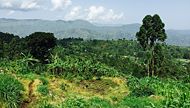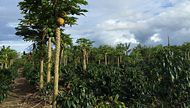IKI talks with Musonda Mumba

Since 2010, the IKI has been providing support through the Ecosystem Based Adaption Flagship programme to communities in the mountainous regions of Nepal, Peru and Uganda in adapting to the impacts of climate change. Musonda Mumba from the United Nations Environment Programme coordinates the project.
Since 2010, the International Climate Initiative (IKI) has been providing support through the Ecosystem Based Adaption (EBA) Flagship programme to communities in the mountainous regions of Nepal, Peru and Uganda in adapting to the impacts of climate change. Musonda Mumba from the United Nations Environment Programme (UNEP) coordinates the project. The interview took place as part of an EBA Flagship workshop in Nepal.
Interview with Musonda Mumba
The Ecosystem Based Adaptation in Mountain Ecosystems Flagship Programme is supporting people in adapting to the impacts of climate change in Nepal, Peru and Uganda. Why did you decide to implement this project on three different continents?
Mumba: The reason why we are covering these three continents was partly due to the possibility of comparing the various issues that are being dealt with in the different ecosystems. While Peru and Nepal are high mountain ecosystems, well over 4000 meters above sea level, Uganda is a mountain ecosystem which does not reach the altitude of the other countries. Accordingly, the dynamics that are affecting the communities in all three countries are very specific. At the same time, we wanted to make sure that we better understand and communicate the global scope of the impacts of climate change on these people.
That means different climate change impacts bring about different challenges. Could you please describe some of the similarities and differences which you have encountered in your work?
Mumba: Looking at the similarities, all three places are obviously affected by climate change in terms of reduced precipitation, for instance. The communities have to adapt to these changes, and also to the social changes in their areas. However, the actual complexity of the social issues is very unique in each place. In Uganda the population density is very high. It is one of the most densely populated areas in the world - round about 10 households or more for every square kilometer. Also, the morphology and geology in the mountain area makes it very different from the Andean range. It is forested, but also very, very prone to landslides. The Andean range has smaller and aging communities due to the migration of young people to the cities searching for jobs outside of the agricultural sector. The people in the Andean range are predominantly pastoralist, with cattle and in some cases lamas. In the Nepalese case the region has a similar population structure and is also dealing with migration. But additionally the communities have to deal with other livelihood issues such as growing certain crops and trying to find markets for them. The crops are very dependent on the rainfall patterns. And these are high value crops which are for example used for pharmaceuticals. So you can see that many differences prevail, and it is these differences that are enriching our work.
The aim of this project is to enable communities to make use of ecosystem services in order to adapt to climate change. What does this look like on the ground?
Mumba: These communities are dependent on provisioning and regulating ecosystem services, for example flowing water, fire wood or climate regulation. But also these areas are very special to these communities in the sense that they also have a cultural value. In both, Peru and Nepal, a number of areas are sacred. And they are also very aesthetic. The services that the ecosystems provide have a value that can both be monetary and non-monetary, and they are closely related to the survival of these communities. But in some cases there has been a change in these ecosystem services. I give you the example of Uganda: In one of the communities where we were working we discovered that land degradation was causing a reduction in water flow - a really critical service for survival, obviously. As a consequence we managed to work very closely with the communities to better understand the causes of the degradation and to educate them on how to restore the degraded areas. Once an ecosystem is resilient, it strengthens the capacity of the people to adapt.
Could you provide us with another example of the achievements the project has accomplished so far?
Mumba: In all the work we have done we avoid providing prescriptive solutions to communities. Instead we initiate a participatory process - particularly involving women and people of different ages - designed to better understand how the environment has changed over time. On this basis we are able to decide collectively what the appropriate solutions should be. In Peru, for instance, together with the communities we have been able to restore pastureland which had been completely degraded and overgrazed. The solution has to come from the people and then we support them. We are trying to figure out together, how they can adapt better and how to restore the ecosystems. At the policy level we discussed with governments why ecosystem-based adaptation is a useful approach to helping communities and economies to adapt to climate change and be more resilient. Economies, especially in developing countries, depend strongly on natural resources. In these conversations we are often asked how long it takes to attain success. Our answer is that it’s a catalytic process that requires long term investments to see tangible results that will be beneficial to the communities and to the national level.
You just mentioned long-term ecosystem restoration processes. Irrigation schemes, on the other hand, bring positive effects quite rapidly. Could you describe a short-term benefit from one of your projects?
Mumba: Sure. In the Ugandan case described earlier we were able to combine different approaches. The first is an engineering intervention using an artificial gravity flow scheme to bring water from the upper ridges to the lower ridges of the mountain. With this, farmers are able to access water, which is essential for food supply. The positive outcome was observable after six month. This meant that the people were able to leave the area where the water was coming from to recover in order to provide the service of water flow regulation again. This intervention, that was not necessarily "green" per se, it complemented the work that we are doing by proving results within a short period of time.
Thank you very much. We wish you all the best for the implementation of the project.
The link has been copied to the clipboard
Contact
IKI Office
Zukunft – Umwelt – Gesellschaft (ZUG) gGmbH
Stresemannstraße 69-71
10963 Berlin











